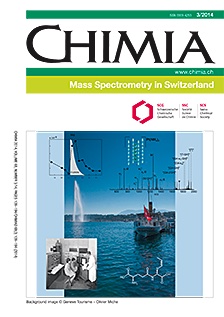Vitamin E and Vitamin E Acetate Absorption from Self-assembly Systems under Pancreas Insufficiency Conditions
DOI:
https://doi.org/10.2533/chimia.2014.129Keywords:
Bioavailability, Chronic pancreas insufficiency, Self-assembly systems, Vitamin eAbstract
We determined the bioavailability of vitamin E from self-assembly structures in patients with diagnosed chronic pancreas insufficiency. Vitamin E solubilized in dispersed inverted bicontinuous cubic phase and in micellar formulation was delivered directly to the small intestine by tube-feeding. A cross-over study with randomization of 6 subjects and 2 treatments including a combined dose of 18 mg (27 IU) of vitamin E (RRR-[5,7-methyl-(2H6)]-?-tocopherol) and 27 mg (27 IU) vitamin E acetate (RRR-[5-methyl-2H3]-?-tocopheryl acetate) was applied over a time period of 1 h. Plasma samples were collected for 56 h and analyzed by liquid chromatography–mass spectrometry. Appearance of labeled tocopherols originating from the treatment started at 25 h and reached Cmax (0.6–4.6 ?M depending on subject) in the 7–9 h window. From the Tmax onwards, both forms of tocopherols diminished slowly to 30–50% of their maxima within 56 h. Strong inter-individual variation was observed in the plasma appearance curves (relative standard deviation varied between 38–45%). No significant discrimination was found between the absorption of free or acetylated forms of deuterated ?-tocopherol confirming that application of acetylated ?-tocopherol provides the same bioavailability as free ?-tocopherol. This observation is valid in both dispersed inverted bicontinuous cubic phase and micellar formulations. Furthermore, since the area-under-the-curve values from cubic phase and from micellar formulations are similar, the cubic phase formulation could represent an alternative delivery system for lipophilic micronutrients in conditions or studies where polysorbate-based micelles cannot be generated.Downloads
Published
2014-03-26
Issue
Section
Scientific Articles
License
Copyright (c) 2014 Swiss Chemical Society

This work is licensed under a Creative Commons Attribution-NonCommercial 4.0 International License.
How to Cite
[1]
K. Nagy, B. Holst, J. Santos, M. Kussmann, L. Sagalowicz, S. Acquistapace, J. Moulin, M. Beaumont, J. R. Malagelada, F. Azpiroz, V. Puig-Divi, L. Ramos, S. Braga-Lagache, M.-C. Courtet-Compondu, B. Lobo, G. Williamson, Chimia 2014, 68, 129, DOI: 10.2533/chimia.2014.129.







